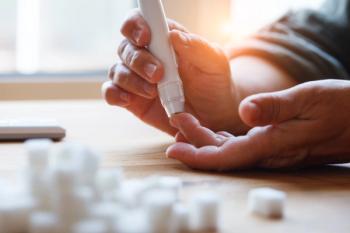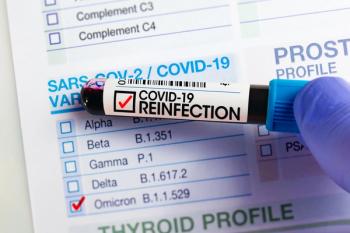
Lonhala Magnair for COPD: What Pharmacists Should Know
The FDA approved this nebulized long-acting muscarinic antagonist in December 2017, and it is expected to be launched this spring.
In December 2017, the FDA approved
Here are key therapeutic areas with Lonhala Magnair that every pharmacist should know.
Indication2
Lonhala Magnair is an anticholinergic indicated for the long-term, maintenance treatment of airflow obstruction in patients with COPD.
Limitation of Use2
Lonhala Magnair is not indicated as rescue therapy for the treatment of acute bronchospasm or for asthma. Additionally, the medication is not indicated for use in children, as the efficacy and safety in this population have not been established.
Additionally, it should not be initiated in patients during acutely deteriorating or potentially life-threatening episodes of COPD, as it has not been studied in subjects with acutely deteriorating COPD.
Mechanism of Action2
Glycopyrrolate is a long-acting muscarinic antagonist that exhibits pharmacological effects through inhibition of M3 receptor at the smooth muscle leading to bronchodilation. Notably, the bronchodilation following inhalation of glycopyrrolate is thought to be predominantly a site-specific effect.
Formulation and Storage2
Lonhala Magnair is supplied as a 1 mL clear, colorless, and sterile solution in unit-dos vials wrapped in foil. It is available in 2 package configurations: a starter kit containing 60 unit-dose vials packaged with one Magnair and a refill kit containing 60 unit-dose vials packaged with a Magnair handset refill. Each package contains 30 foil pouches with 2 vials per pouch. The dosage for each individual vial is 25 mcg of glycopyrrolate.
Lonhala Magnair vials should be stored at room temperature in the protective foil pouch. After opening the foil pouch, unused unit-dose vials should be returned to and stored in the foil pouch. Once a foil pouch is opened, discard the vials if not used within 7 days. An opened unit-dose vial should be used right away.
Dosing2
The recommended dose is inhalation of 1 vial twice daily, using the Magnair device. Each treatment should take about 2 to 3 minutes.
Lonhala Magnair should be administered at the same time of the day (1 vial in the morning and 1 vial in the evening). Remove the vials from the foil pouch only immediately before use.
No dosage adjustment is required for geriatric patients, individuals with hepatic impairment, or those with mild to moderate renal impairment.
Efficacy2
The efficacy of Lonhala Magnair to treat COPD was established in 2 placebo-controlled confirmatory studies. Both trials were randomized, double-blind, placebo-controlled 12-week studies to evaluate the efficacy of Longhala Magnair 25 and 50 mcg twice daily on lung function. The studies treated 1293 subjects who had a clinical diagnosis of COPD, were 40 or older, had a history of smoking greater than or equal to 10 pack-years, a post-bronchodilator FEV1 less than or equal to 80% of predicted. The primary endpoint was the change from baseline in trough FEV1 at day 84 compared with the placebo.
Study results showed statistically significant increases in the primary endpoint with Lonhala Magnair compared with the placebo. Compared with the 25 mcg twice daily, 50 mcg twice daily did not provide a sufficient additional benefit on a variety of clinical endpoints.
Safety2
The most common adverse reactions of Lonhala Magnair reported in clinical trials include dyspnea and urinary tract infection.
Lonhala Magnair should be used in caution in patients with bladder neck obstruction, narrow-angle glaucoma, or prostatic hyperplasia.
Product Comparison3
Manufacturer
Formulation
FDA Indication
Dosing frequency
Lonhala Magnair (glycopyrrolate)
Sunovion
Inhalation solution
COPD
Twice daily
Seebri Neohaler (glycopyrrolate)
Sunovion
Inhalation capsule
COPD
Twice daily
Spiriva HandiHaler (tiotropium)
Boehringer Ingelheim
Inhalation powder
COPD
Daily
Spiriva Respimat (tiotropium)
Boehringer Ingelheim
Inhalation spray
COPD, asthma
Daily
Tudorza Pressair (aclidinium)
AstraZeneca
Aerosol powder
COPD
Twice daily
Patient Counseling2
Patients should be instructed to store the medication vials in the sealed foil pouch and only open the pouch immediately before use. Unopened vials should be returned to the opened foil pouch for use at their next treatment and discarded if not used within 7 days or it may not be as effective. Discard any vials if the solution is not colorless.
If a patient misses a dose of medication, they should use their next vial at the usual time. Patients should be instructed to not use 2 vials at one time and to not use more than 2 vials in a day.
Patients should be informed that Lonhala Magnair is not meant to relieve acute symptoms of COPD, and extra doses should not be used for that purpose.
The old handset parts should be thrown away after using 60 vials of the medication, and the replacement handset parts should be used with the next 60 vials.
Steps for Use2
Assembling the Magnair device (refer to the package insert for instructions with pictures):
- Step 1: Wash your hands.
- Step 2: Open the top of the handset body by lifting the clasp.
- Step 3: Hold the aerosol head with the silver text side facing up, and insert it into the handset body.
- Step 4: Close the handset body, making sure that the aerosol head is properly inserted and you hear a click.
- Step 5: Attach the mouthpiece to the handset body, making sure that the blue value is pressed down into the slot on the mouthpiece.
- Step 6: Connect the controller to the handset body using the connection cord.
Using Magnair Lonhala:
- Step 1: Using clean hands, open the foil pouch to remove the 2 vials. Separate the vials, and return 1 back in the foil for later use.
- Step 2: Insert 1 vial into the medication cap. If inserted correctly, you should hear a click.
- Step 3: Attach the medication cap with the inserted vial to the handset body by turning the cap clockwise until you hear a click.
- Step 4: Insert the mouthpiece into your mouth sitting upright.
- Step 5: Turn on the controller.
- Step 6: Breath in and out normally throughout the mouthpiece. Continue for 2 to 3 minutes until the controller automatically shuts off and you hear 2 beeps.
References
1. COPD Foundation. COPD statistics across America.
2. Lonhala Magnair [prescribing Information]. Marlborough, MA: Sunovion Pharmaceuticals, Inc; 2017. accessdata.fda.gov/drugsatfda_docs/label/2017/208437lbl.pdf. Accessed February 23, 2018.
3. Lexicomp Online, Lexi-Drugs, Hudson, Ohio: Lexi-Comp, Inc; February 17, 2018.
Newsletter
Stay informed on drug updates, treatment guidelines, and pharmacy practice trends—subscribe to Pharmacy Times for weekly clinical insights.


















































































































































































































